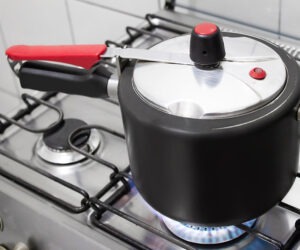Sour Mashing Techniques

Soured beers are quickly gaining popularity among beer lovers and brewers alike. Greg Noonan at Vermont Pub & Brewery in Burlington, Vermont is one brewer getting in on sour mashing currently with four beers in his line-up, a wheat beer, a Flanders red, a wit beer, and a framboise. While a sour mash is not traditional with these beer styles, it is one technique you can utilize to create the sour characteristics in these beers. It doesn’t matter whether you are an extract or all-grain brewer, a sour mash is a fairly easy process that requires little in the way of special equipment.
Traditionally there were two reasons for a brewer to purposefully sour mash. The first was to biologically acidify the mash to comply with the Rheinheitsgebot Purity Law. Utilizing a sour mash for biological acidification of pale brews produces a “softer” malt profile. The second reason was to make a true sour beer like a Kentucky Common, which distillers in the Appalachian Region of the US made as an offshoot to their sour-mashed whiskey.
There are several methods you can employ to create a soured beer. Simple techniques include adding lactic acid to your brewing water or including acidulated malt to your grain bill. Both techniques are going to lower the pH levels of both the mash and final wort, giving a tart, sour edge to the final beer depending how much is added. More advanced techniques include adding either cultured lactic acid bacteria or Brettanomyces, a mixed lambic culture of Brettanomyces, Pediococcus and Lactobaccillus or oaking the beer with unsanitized oak ingredients while the beer is in secondary stages of fermentation. The final technique in the homebrewers quiver would be performing a sour mash, which is the only technique I will be discussing in this article.
The goal of a sour mash is to employ the work of Lactobaccillus delbruckii to a great extent while limiting the work of other critters such as fungi or bacteria like Acetobacter or Clostridium. You can accomplish this by pitching a live culture of Lactobaccillus, by controlling the temperature of the mash and by limiting the oxygen introduced to the mash. Acetobacter, as the name implies will produce acetic acid, the key acid in vinegar. Acetobacter will only play a significant role if the sour mash is incubated for an extended time period. You will know when Acetobacter has taken hold when the mash vessel, upon opening, has a cidery-like vinegar smell. While you would like to minimize the vinegar included in the mash, it will not spoil your attempts at creating a clean sour beer if kept in check.
Acetobacter needs oxygen and will only grow on the top of the mash. If you seal the top of the mash by laying some plastic wrap across the top, pushing all the air bubbles out in the process then you can greatly decrease the opportunity for Acetobacter to act. Clostridium on the other hand produces butyric acid, which is a foul-smelling acid, faintly resembling my freshman year dorm, a mixture of rank locker room smell mixed with vomit. If Clostridium takes hold in the mashing vessel, it is rather apparent right away and make sure to keep away from significant others if you enjoy their company. I would advise dumping the mash if Clostridium takes hold. But some people seem to be okay adding this rank concoction to their beer stating that the odor can be boiled away. In general, a foul-smelling mash is going to yield a foul-smelling beer. A little “funk” in the mash is OK (some aromas will get scrubbed in the boil and fermentation), but too much and it should be discarded. Skimming the top of the mash can get rid of many off odors. A good sour mesh smells “cleanly” sour. L. delbruckii produces lactic acid, an odorless acid that got its name because it is the spoiling agent in milk when lactose is broken down.
There are some basic items you will want to have in your possession before attempting a sour mash. In my opinion a pH meter is important, especially if you’re an all-grain brewer. They will start at $30 for a simple digital meter plus you will want to buy a calibration kit, which you can get for under $10. Other key pieces include a thermometer and a small mash container that you can seal up tight. A small, insulated cooler will work well in a pinch. This will also help regulate the temperature of the mash over the course of several days. If you have a space in your house that can hold the temperature above 100°F (38 °C) for several days like a furnace room or hot water heater then you can also utilize a gallon jug or even smaller, depending on the size of your sour mash. One key to a good clean sour mash is that your container be filled right to the top for the incubation period.
So what type of beers might you utilize a sour mash for? Really the sky is the limit, but a short list of good examples would include, but not limited to Berliner Weisse, lambic-styled beers, Flemish reds and browns, stouts, porters, summer ales, weizens, wits, saisons and the more obscure style Kentucky Common. From my experience hoppy beers don’t seem to benefit from the effects of souring but maybe that is the reaction of my taste buds. The sour mash will add a nice twang to the beer if a moderate percentage of the total grain bill is added and a full pucker face if a large percentage of soured grains are added. Utilizing 5% of the total grist for the sour mash is generally the lowest end of spectrum. This is in the realm of using the sour mash for mash acidification. That means that if your recipe calls for 10 lbs. (4.5 kg) of grist then your sour mash would contain 0.5 lb (0.23 kg) of your base grain.
The question on how much sour mash that one should add is really dependent on the brewing water you will be utilizing, the end pH of the sour mash, and the extent of sourness you are looking to achieve. The stronger the buffering capacity of your brewing water, the higher the carbonate levels, the more sour mash you will need to add to achieve your desired effects. A 10% sour mash using soft water may produce the same results as a 15% mash when hard water is utilized. Trial and error is really the only way a homebrewer will achieve their desired level of sourness. The end pH of the mash is also very important, especially to all-grain brewers because ideal mash pH should lie in the range of 5.2–5.4.
According to Greg Noonan, “a 2-day sour mash will give a better flavor but half the acidity of a 3-day mash.” In acidified beers, the sour mash is stirred into the main mash to hit a proper mash pH. In sour beers made with a full sour mash (Kentucky Commons, for example), the malts are mashed normally, then allowed to cool and sour. A brewer could also make a sour beer by stirring a large sour mash into the main mash after conversion has taken place. This would work well for moderately souring experimental beers. The percentage of mash which is soured will play the biggest role. Souring between 5–20% of the grain bill will give the beer anywhere from barely a touch of sourness to a nice twang. If you sour above 20% of the total grain bill, then you are entering true sour beer territory. Some homebrewers will sour mash upwards of 50% or more of their total grain bill. This quantity is ill-advised for anybody who doesn’t want a true pucker-up beer or anybody that suffers from acid-reflux problems.
For first time sour mashers I would recommend souring between 5–20% of the total dry grist. This will give you something to work with for your next sour mashing session. Begin the sour mashing process two to four days prior to brewing the entire batch. Calculate how much of your base malt needs to be soured. You can use crushed 2-row, 6-row, pale ale or Pilsner malt. Begin by heating 1.25 qts. (1.18 L) of water for every 1.0 lb. (0.45 kg) of grain in the mash, up to a temperature of about 162 °F (72 °C). In a pot, slowly mix the water into the grains and stir thoroughly. Wrap the pot in a towel and let the mixture stand for 40 minutes. After the 40 minutes, heat the mash up to 170 °F (77 °C) and hold for 10 minutes. Gently pour the mash into the vessel it will be stored in for the next several days, introducing as little oxygen is possible to the mash while pouring. The less oxygen introduced during this process, the less chance there is for mash spoiling critters to take control. Cover tightly with plastic wrap making sure to expel any air bubbles trapped on top and cool the mash down to roughly 115 °F (46 °C).
Inoculating (pitching the critters) in the sour mash is the final critical choice in the sour mashing process. The simplest and most straightforward technique is to keep a handful of dry grains from the preceding mashing steps, either crushed or whole grains work. Simply toss in the grains when the temperature of the mash falls below 120 °F (49 °C). The grains already contain the bacteria L. delbruckii in their husks. Another way would be to pitch a culture of live bacteria. Both Wyeast and White Labs have made this strain available to homebrewers, or you may be able to find live cultures in some health food stores as packaged yogurt culture. Again pitch the culture when the temperature falls below the 120 °F (49 °C) threshold. Reseal the vessel and place in a warm spot. The closer you can keep the mash to the 120 °F (49 °C) mark without going over, the better your Lactobacillus will fair and the less likely unwanted visitors will take control.
When brew day arrives, extract brewers can pour the sour mash through a strainer or colander to separate the grains from the liquid and add the sour liquid directly to the boil. Give a smell to the sour mash. How does it smell? If it smells foul, then it should go down the drain. If it smell a little funky, but not off-putting, then you may consider adding maybe a portion or adding it all prior to boil. If it smells fairly clean, then feel free to add it either to the mash (for all-grain brewers) or all of it to the boil.
The all-grain brewer may follow the same procedure as the extract brewer, or if biological acidification is your goal then add the sour mash to the main mash. Just be aware that you don’t want the mash pH to fall below the 5.2 threshold as enzyme activity can quickly become adversely effected. Begin by mashing the grains as normal in your mash tun. You will want to heat the sour mash up to your first rest temperature to avoid any complications with volume and temperature of strike water to add. If your goal is to make a more sour beer, then you can add the remainder or all of the sour mash with a few minutes left in the boil to raise the sour intensity. Adding fairly clean sour mashed wort at the end of the boil allows some of the interesting compounds produced in the sour mash to add to the fermentation complexity of the beer.
So now that you have some general guidelines it’s time to turn brainstorming into reality. Sour mashing can be both a fun and frustrating side project to brewing. As you gain practice in the technique, it becomes easier over time and you can start culturing your own strains of bacteria or yeasts for souring. Lactobaccillus is a nice straightforward bacteria for souring a beer but there are several other strains of bacteria and yeast that can be utilized and provide interesting characteristics. So experiment and don’t be afraid to ask questions because a sour beer when done properly is a beautiful thing.



